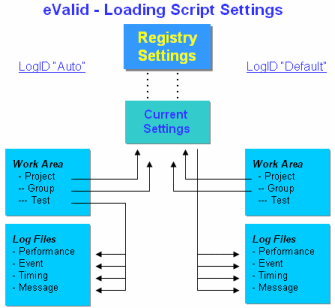|
|
Recording A New Script
Playing An Existing Script
How Logfiles Are Determined
General Rules & Explanations
Summary
This page explains how eValid processes folder and file names from various points of view.
Creating A Test Suite Folder Hierarchy and Individual Test Scripts
The
Project/Log Management settings Menu
controls
how new eValid test recordings are named and stored.
There are usually two steps to this process:
|
(Project/Log Management Settings) These files are used to establish the working folder, plus the location in the 3-level hierarchy of Project > Group > Test. eValid rules aimed to prevent faulty naming are described here. | ||||
| Area | Purpose | What's Allowed | eValid Response | Hints |
| Working Folder (Working Folder) | Area where projects, groups, test scripts are put. | Path to already-existing working folder. | Does not accept blank.
Checks validity of folder. Requires a drive letter [C:\] or Networked computer prefix [\\]. | Choose a folder where you want all of your work to be stored. |
| Project Name | Name of your project (a set of groups of tests). | Non-blank folder name. | Does not accept blank.
Field cannot contain any: \ : / * ? " < > | # + characters. Existence of folder is not checked. eValid will create the folder if needed. | Choose a meaningful name for your project, one that describes what all of tests in the project are about. |
| Group Name | Name of one of your group of tests. | Non-blank folder name. |
Does not accept blank.
Field cannot contain any: \ : / * ? " < > | # + characters. eValid will create the folder if it it needs it and it does not exist. | Choose a meaningful name for this group in your test project, one that describes what all of tests in the group are about. |
| Test Name | Your test script name (file name). | Non-blank test file name. |
Does not accept blank.
Field cannot contain any: \ : / * ? " < > | # + characters. When you start a recording this name will be the initial name of the test. If at that time you change the test file name, the new name is stored in this field. | Choose a meaningful name for your test, so you can remember what the test is for. |
|
(Project/Log Management Settings) These files are used by eValid as the Event Log (-E.log) and the three subsets of the event log: Mesage Log, Performance Log, Timing Log (-M.log, -P.log, -T.log). | ||||
| Area | Purpose | What's Allowed | eValid Response | Hints |
| Log File Names | File names for log data. | Non-blank file name or full path name to file. |
eValid checks that the path name would be legal,
but does NOT check existence of the file,
which is assumed to already exist at playback time.
Field cannot contain any: \ : / * ? " < > | # + characters, and can only contain : and \ if a full path is used. If left blank, eValid fills in the name Test Name-E.Log from what is in the Test Name field. This applies to the -M.log, -P.log, -T.log. | If you choose Auto-name Log Files during your recording from the script name dialog, or if you edit your script to say LogID "Auto", eValid will name all of the log files after the specified Test Name. |
Playing a Script That Already Exists
There are usually two steps to this process:
Regular Windows file conventions and procedures are used to identify and select the script file to play back. The Project/Log Management settings Menu is used to identify where to put the resulting log files.
|
(Project/Log Management Settings) A test script can be opened from the eValid browser (File >> Open Script) or from the script file window (File >> Open.evs). | ||||
| Area | Purpose | What's Allowed | eValid Response | Hints |
| Log File Naming on Playback | How log files are named on playback. | Pre-defined files as described above. | On playback, regardless of where the script was stored, the names defined in the current settings [i.e. whatever is stored in the registry] are used for the log files. | It may make sense to use a Profile to recover the locations of logs for script playback. |
Effect of LogID In Playback Script
The diagram below shows how the value in the LogID script command
affects the delivery of logfiles.
Note that in both cases the information in the script file in the
ProjectID and
GroupID
fields is reflected back into the curent settings.
However, the test name is NOT reflected in this way,
in order to allow creation of a new test in
the same Project and Group.

Summary of Record/Play File Actions and Interactions
Here are additional details about how eValid behaves when
you are doing simple things
and deviating from the preset (registry) settings or your current settings.
Remember, eValid's current settings values:
Here are the groundrules for typical situations.
In this case the defined LogFile names will respect the defined working folder AND the Project folder name AND the Group folder name. eValid will create these names if necessary.
However, if complete paths appear in the current settings then eValid will use those complete path names without checking anything else about these paths (eValid assumes the complete paths are present).